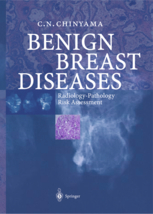Catherine Chinyama has made a creditable attempt to bring order to the often confusing field of
benign breast disease. She begins with an overview of diagnostic approaches -- radiologic,
surgical, and pathological -- and then gives a detailed description of specific types of benign
breast disease that are organized predominantly by pathological findings. The book concludes with a
discussion of risk assessment for patients with the condition. The author addresses one of the
major challenges in the field -- a lack of agreement among practitioners regarding terminology --
in a discussion of the various terms used for each benign breast condition, although terminology
that is used in the United Kingdom predominates. The main focus of the book is on radiologic and
pathological findings in benign breast disease and the implications of those findings as breast-
cancer risks. Clinical issues are addressed in less detail and mainly to place the radiologic and
pathological findings in context. The book is remarkably well illustrated, with more than 170
figures showing the results of mammography and ultrasonography and histologic images. The figures
are informative and clarify points discussed in the text, and many of the images will serve as
references for pathologists and radiologists as they interpret their findings. The range of benign
breast disease covered in the book is broad, and the notable omission of infectious lesions and
problems arising during pregnancy and breast-feeding reflects the fact that such conditions are not
associated with the risk of breast cancer. The inclusion of recent advances in molecular pathology
provides a biologic basis for discussions of the association of specific lesions with breast cancer
and brings a 21st-century approach to the long-standing challenge of deciding which benign breast
lesions are precancerous and which are not. Throughout the book, Chinyama reviews the often
inconsistent findings in the literature regarding the breast-cancer risk associated with various
benign breast lesions; she reports not only on the relative risks but also on the absolute risks
during a defined period. For example, the relative risk of breast cancer in women with atypical
ductal hyperplasia is reported to be 4.4 as compared with women without proliferative disease,
whereas the absolute risk within 10 to 15 years is 10 percent. The influence of a patient's family
history on these general risks is addressed. Despite this attention to detail, the chapter on risk
assessment is the weakest one in the book. A more critical approach to studies of risk evaluation
would have been useful, since it would have given more weight to the results of cohort studies
instead of case-control studies. The book emphasizes the use of Wolfe mammographic patterns rather
than tissue density as radiologic determinants of risk, although both methods are discussed.
Furthermore, the results of the Women's Health Initiative (a randomized trial that showed a clear
increase in breast-cancer risk among women receiving combined hormone-replacement therapy) are not
included, despite a discussion of the methodologically weaker Million Women Study, which was
published later. Offsetting these limitations is Table 12.1, a gem that provides a well-referenced
summary of relative breast-cancer risks that are associated with various pathologically defined
benign breast diseases. The book would have been strengthened by a discussion of common clinical
presentations of benign breast disease -- for example, generalized lumpiness, dominant lumps, and
both cyclical and noncyclical breast pain -- as well as a review of normal breast anatomy and
development. Furthermore, Chinyama refers to the need for multidisciplinary meetings to address
correlations between radiology and pathology in managing benign breast disease but does not make
recommendations regarding the nature or format of


